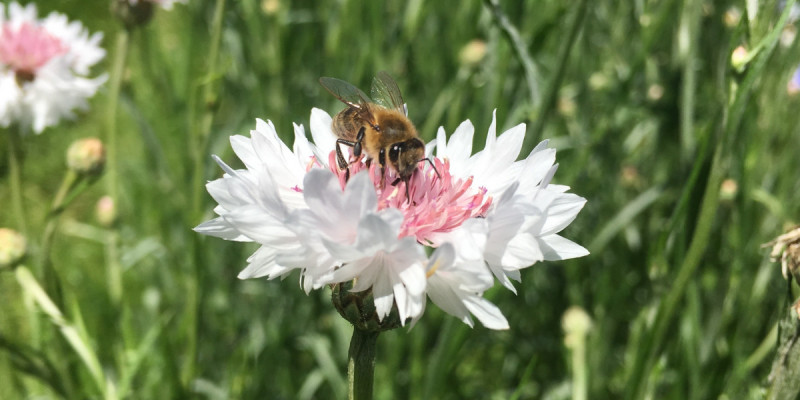Adding Perennials to Our Cut Flower Garden
Cedar Circle’s cut flower garden has been managed in an annual system for many years—meaning, plants were seeded and planted every spring, and then “terminated” by flail mowing, tarping, or tilling at the end of every season. Although some of the plants were perennials (plants that live for many years), managing annually helped with pest, disease, and weed management, and ensured productivity for event flower harvests year after year.
So why change our current system by adding more perennials? Lots of reasons!
As a community farm and education center, we are continually evolving our growing practices to ensure we deliver on our mission to support organic, regenerative farming and the transition to a localized food economy. In fall 2023, we began to transition a portion of the cut flower garden to a perennial production system to help:
- Increase native plants in our landscape (such as Aster Novae Angliae and Rudbeckia laciniata);
- Support pollinators (including native pollinators such as the yellow-banded bumble bee and Viereck’s sweat bee),
- Reduce our carbon footprint by decreasing our inputs and ecological waste (plastic pots, water, fertilizer) as well as the period of time we’re heating our greenhouse in the spring; and,
- Build soil health with less tillage in the garden and using deeper rooted perennial plants to feed soil biology.
Incorporating more perennials into the garden will also mean fewer inputs—seeds, plastic, water, and labor—which are required each spring to support seedlings, planting, tilling and preparing the ground, and initial irrigation to help establish plants.
For a small to mid-sized farm like Cedar Circle, a transition like this one can have a big financial impact. There are upfront costs, changes to pest and disease control, and shorter bloom times (which translates to a decrease in sales revenue). And for this reason, we’ll implement the perennial system in phases, with the goal of converting half of the flower garden to perennials over the next 5 years (all while continuing to grow annuals in the rest of the garden, of course!).
You’ll still find an abundance of flowers in the garden during this transition; We are still planting our regular annual flowers for events, weddings, and the PYO Bouquet CSA program, with the perennials incorporated as additions to the cut flower program.
Managing these two systems side by side will allow us to conduct research comparing the impacts on pollinators, and evaluating the cost of implementation, maintenance, and productivity for flower sales.
We’ve already converted one 30 ft by 100 ft plot and plan to convert three more of that size by 2025. We’ll also add a hedgerow to incorporate woody trees and shrubs into the landscape for additional wildlife and pollinator support.
We can’t wait for you to see our perennial transition in action! Here’s what to expect in the coming year and beyond:
- Signage will be added to the converted portion of the garden so that guests and visitors can use the garden as a living laboratory, learning about, and exploring, perennial plants.
- Our retail area, outside the farmstand and greenhouses, has been revamped to feature perennials we like to call “plants with a purpose” that include only pollinator support, edible, medicinal, native plants and native cultivars.
- In the future, we’ll host workshops, classes, and volunteer activities around native landscaping, landscaping for pollinators, seed collection and native plant propagation to build knowledge and resilience into our community and to help our Annual and Perennial Department contribute significantly to our mission as a nonprofit organization.
Look for these perennial blooms in 2024:
- Filipendula rubra (Venusta)
- Monarda fistulosa (Fistulosa)
- Schizachyrium scoparium (Little bluestem)
- Helenium autumnale (Autumnale)
- Eupatorium dubium (Dubium / Three-nerved Joe Pye)


Event & Wedding Flowers
Are you looking for just the right flowers for your wedding or special event this year? We have just what you need! “Pick your own” locally grown, certified organic flowers in our cut flower garden, or have us harvest for you! Either way, we guarantee a meaningful addition to your celebration from root to vase!







